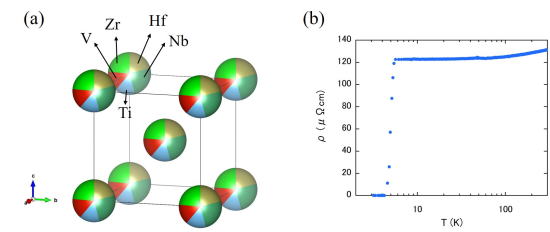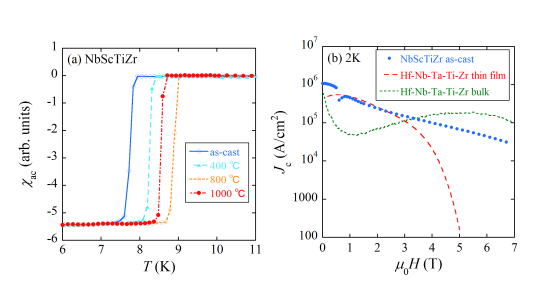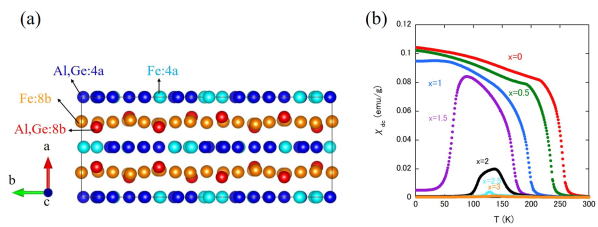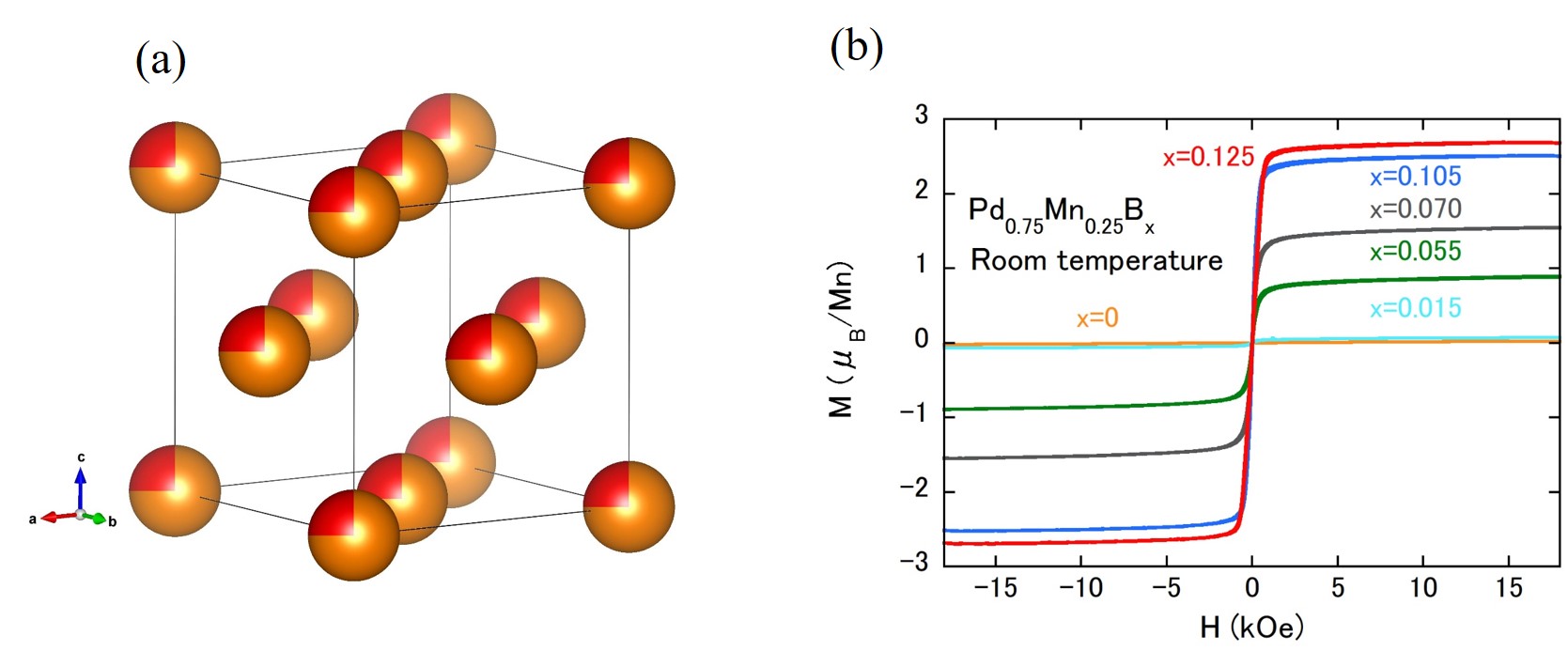Current Research
1. New compounds
1-1 New high-entropy alloy superconductors
Many alloys support our society. Conventional alloys that typically have a single principal element with minor additive elements have been used since ancient epochs. Recently, a high-entropy alloy (HEA) that consists of multiple elements as its primary constituents has garnered substantial attention due to its exceptional mechanical, catalytic, and magnetic attributes. The exploration of HEA superconductors has been a growing research area following the identification of the body-centered cubic (bcc) HEA superconductor Ta34Nb33Hf8Zr14Ti11 in 2014. HEA superconductors manifest distinctive features, such as the robustness of superconductivity under extremely high pressure. Additionally, certain HEA superconductors exhibit a noteworthy critical current density, pivotal for practical applications. Globally, researchers are conducting materials research on HEAs, exploiting the expansive compositional space to unveil novel phenomena. Our ongoing research focuses on body-centered cubic (bcc) HEA superconductors, and we have found that Hf21Nb25Ti15V15Zr24 is a new HEA superconductor with a superconducting critical temperature of 5.3K.
Publication: "New high-entropy alloy superconductor Hf21Nb25Ti15V15Zr24" Results in Physics 13 (2019) 102275.

Gum metals, notable for their anomalous mechanical characteristics like superelasticity and low Young's modulus, share chemical compositions akin to bcc HEA superconductors. If gum metals exhibit superconductivity, they hold considerable promise for fabricating superconducting wires, positioning them as plausible candidates for next-generation superconducting materials. Prompted by reports of gum metal-like behavior in Al5Nb24Ti40V5Zr26, our investigation delves into the superconducting properties of Al-Nb-Ti-V-Zr HEA alloys. All prepared samples exhibit superconductivity below 4.7-7 K. The correlation between the superconducting critical temperature and the valence electron concentration per atom mirrors that of conventional bcc HEA superconductors. .
Publication:"Superconductivity in Al-Nb-Ti-V-Zr multicomponent alloy" Supercond. Nov. Magn. 34 (2021) 2787.
The influence of the high-entropy state on superconductivity remains elusive. We have found that bcc equiatomic HfMoNbTiZr HEA is a type-II BCS superconductor. Furthermore, a comparative analysis of superconducting properties among equiatomic quinary bcc HEA superconductors reveals a notable revelation: the superconducting critical temperature Tc in HEAs diminishes with an escalating Debye temperature ΖD, contradicting the anticipated trend in the BCS theory. This unexpected finding is elucidated by a shortened phonon lifetime at higher ΖD, attributed to phonon broadening resulting from atomic disorder and the uncertainty principle. We computed Tc as a function of ΖD and the electron-phonon coupling, presenting a contour map featuring four equiatomic HEAs (A: HfNbTaTiZr, B: HfNbReTiZr, C: HfNbTaTiV, and D: HfMoNbTiZr). In HEA superconductors, moving from A to D along the dotted guideline corresponds to increasing ΖD and decreasing electron-phonon coupling, Tc is systematically lowered, which supports the reduction of Tc with increasing ΖD.
Publication:"Superconductivity and hardness of the equiatomic high-entropy alloy HfMoNbTiZr" Journal of Alloys and Compounds 924 (2022) 166473.

Although the high-entropy alloys mentioned earlier predominantly exist as single-phase alloys, their vast compositional space allows for diverse microstructures, including eutectic structures exhibiting fine lamellar formations. The correlation between eutectic morphology and superconducting properties remains unclear. The high-entropy alloys provide a fertile ground for exploration. Our research on the impact of annealing in the eutectic high-entropy alloy superconductor NbScTiZr reveals that heat treatment up to 800 induces lattice distortion and microstructural alterations, enhancing the superconducting critical temperature. Furthermore, our investigations indicate that the self-field critical current density of the as-cast sample surpasses 1 MA/cm2 at 2 K, classifying NbScTiZr as a material with notably high critical current density.
Publication:"Effect of Annealing in Eutectic High-Entropy Alloy Superconductor NbScTiZr" Supercond. Nov. Magn. 37 (2024) 1059.

1-2 New high-entropy alloy magnetic materials
The manifestation of ferromagnetism attributed to the Cr magnetic moment in metals is a seldom-encountered phenomenon. High-entropy alloys, endowed with an expansive compositional space, present unprecedented prospects for unearthing novel phenomena. Nonetheless, exploring materials to uncover innovative magnetic behaviors within this vast compositional space remains underexplored. Our investigation has unveiled a ferromagnetic Cr-containing high-entropy metallic alloy, denoted as Ti21`25Nb20`24Cr5`10Ru`49. This study has elucidated that the cubic CsCl-type structure underlies ferromagnetism, with a Curie temperature of 38 K. Electronic structure calculations have been conducted to scrutinize the origin of ferromagnetism. Notably, Cr atoms configure a regular lattice devoid of atomic disorder in the reported ferromagnetic Cr-containing intermetallic compounds. Ti21`25Nb20`24Cr5`10Ru`49, exhibiting atomic disorder, is the first example of a ferromagnetic Cr-containing high-entropy metallic alloy.
Publication:"Discovery of ferromagnetism in new multicomponent alloy Ti-Nb-Cr-Ru" APL Materials 10 (2022) 071101

1-3 Other new compounds
We have identified novel compounds, namely Ce3Pd20As6 with the C6Cr23-type structure and CeCd3P3 with the ScAl3C3-type structure. Recently, the discovery of Fe3Ga0.35Ge1.65 has been made, crystallizing into the Fe13Ge8-type structure. Additionally, our observations reveal that the isostructural Co6.2Ga3.8-xGex exhibits low-temperature giant coercivity, surpassing that of Nd-magnets. The distinctive crystal structure of this compound features Co-triangular and Co-Kagome lattices, indicative of geometrical frustration potentially linked to the emergence of giant coercivity.
Publication:
"Synthesis and physical properties of a new caged compound Ce3Pd20As6 of the C6Cr23-type structure" J. Alloys and Compounds 622 (2015) 676.
"Optical, transport and magnetic properties of new compound CeCd3P3" Mater. Res. Express 3 (2016) 056101.
"Magnetic properties and magnetocaloric effect of Fe3Ga0.35Ge1.65" J. Phys. Soc. Jpn. 91 (2022) 065004.
"Low-temperature giant coercivity in Co6.2Ga3.8-xGex (x=2.4 to 3.2)" Mater. Res. Express 10 (2023) 106102.

2. New functional compounds
2-1 New route for ferromagnetic (FM)-antiferromagnetic (AFM) transition
The ferromagnetic to antiferromagnetic (FM-AFM) transition in Fe-based compounds is rare. Some examples exist with structurally simple crystal configurations, such as FeRh1-xPtx and Ce(Fe1-xCox)2. Our investigation into Al8.5-xFe23Ge12.5+x solid solutions unveils a FM-AFM transition within a specific x range. Interestingly, this system possesses a very complex crystal structure. This suggests that a complex crystal structure may constitute a novel avenue for observing the FM-AFM transition.
PublicationF"Competition between ferromagnetic and antiferromagnetic states in Al8.5-xFe23Ge12.5+x (0 x 3)" Journal of Solid State Chemistry 284 (2020) 121188.

2-2 Emergence of room-temperature ferromagnetism by interstitial elements in Mn compound
Mn-based compounds play a pivotal role in obtaining both ferromagnetic and antiferromagnetic materials. For instance, MnBi is renowned for its ferromagnetic properties, while Mn3Sn garners attention as a topological antiferromagnet. In Mn-based compounds, the magnetic state is widely acknowledged to be highly sensitive to the Mn-Mn distance, modifiable by adding light elements. Our discovery that a spin-glass Pd0.75Mn0.25 alloy transforms into the room-temperature ferromagnet Pd0.75Mn0.25Bx by incorporating boron atoms represents a rare phenomenon in bulk Mn-based compounds. The Curie temperature and saturated Mn moment in Pd0.75Mn0.25Bx surpass those of hydrogen-absorbed Th6Mn23, which has been the sole example of interstitial atom-induced room-temperature ferromagnetism thus far. In rare earth-Fe-based permanent magnets, the insertion of light elements enhances ferromagnetic properties. However, it would be possible to study a change in magnetic states in Mn-based compounds, such as paramagnetism to ferromagnetism, antiferromagnetism to ferromagnetism, and so on. Our results pave the new way in the research of magnetic materials.
PublicationF"New room-temperature ferromagnet: B-added Pd0.75Mn0.25 alloy" Journal of Magnetism and Magnetic Materials 468 (2018) 115.

2-3 Discovery of photoinduced Kondo effect
Optical manipulation of magnetism is imperative for magneto-optical devices. The prevailing method relies on thermal effects induced by laser illumination. However, achieving low power consumption necessitates alternative optical control methods. We propose the "photoinduced Kondo effect" as a novel approach to optical magnetism control. We prepare a Ce-based semiconductor in which the unscreened 4f spins of Ce atoms govern the magnetic state of the semiconductor. When optical illumination generates sufficient conduction carriers in a Ce-based semiconductor, the Kondo effect emerges. This induces a nonmagnetic state by forming spin singlets between localized spins and associated carriers, enabling optical magnetism control without invoking thermal effects. We have found the possible photoinduced Kondo effect in CeZn3P3. In practical magneto-optical devices such as MO and MD, the optical density reaches 106 W/cm2. On the other hand, the photoinduced Kondo effect emerges at only 10W/cm2. So, we can expect low consumption next-generation magneto-optic and quantum information/computation devices.
PublicationF"Photoinduced Kondo effect in CeZn3P3" Physical Review B 93 (2016) 035122
3. Other research
3-1 New method of rare earth extraction from NdFeB magnet
The escalating demand for NdFeB magnets, particularly in electric vehicle motors and wind turbines, underscores the urgency for sustainable practices, including Nd recovery from used magnets. While wet processes involving acid are conventionally employed for in-plant sludge recycling, there is a desire for higher selectivity between Nd and Fe at room temperature. Our proposed pretreatment involving corrosion before dissolution into HCl and oxalic acid precipitation attains a Nd recovery ratio of 97%, surpassing conventional oxidation-based methods. This method aligns seamlessly with present in-plant sludge recycling.
The ecological challenges posed by waste acid discharge in wet processes have spurred the proposal of elemental technologies for closed-loop acid processes to reduce environmental impact. However, a demonstration of the reuse of waste acid solution in the actual process flow has yet to be performed. We have presented the first encouraging demonstration of the closed-loop acid process by employing our new extraction method. This marks a significant stride towards realizing closed-loop acid flow in rare earth element recycling.
Publication
E "Improved room-temperature-selectivity between Nd and Fe in Nd recovery from Nd-Fe-B magnet" AIP Advances 5 (2015) 117212. (Joint research with Physonit)
E "Rare Earth Extraction from NdFeB Magnet Using a Closed-Loop Acid Process" Scientific Reports 7 (2017) 8039.
1. New compounds
1-1 New high-entropy alloy superconductors
Many alloys support our society. Conventional alloys that typically have a single principal element with minor additive elements have been used since ancient epochs. Recently, a high-entropy alloy (HEA) that consists of multiple elements as its primary constituents has garnered substantial attention due to its exceptional mechanical, catalytic, and magnetic attributes. The exploration of HEA superconductors has been a growing research area following the identification of the body-centered cubic (bcc) HEA superconductor Ta34Nb33Hf8Zr14Ti11 in 2014. HEA superconductors manifest distinctive features, such as the robustness of superconductivity under extremely high pressure. Additionally, certain HEA superconductors exhibit a noteworthy critical current density, pivotal for practical applications. Globally, researchers are conducting materials research on HEAs, exploiting the expansive compositional space to unveil novel phenomena. Our ongoing research focuses on body-centered cubic (bcc) HEA superconductors, and we have found that Hf21Nb25Ti15V15Zr24 is a new HEA superconductor with a superconducting critical temperature of 5.3K.
Publication: "New high-entropy alloy superconductor Hf21Nb25Ti15V15Zr24" Results in Physics 13 (2019) 102275.

Gum metals, notable for their anomalous mechanical characteristics like superelasticity and low Young's modulus, share chemical compositions akin to bcc HEA superconductors. If gum metals exhibit superconductivity, they hold considerable promise for fabricating superconducting wires, positioning them as plausible candidates for next-generation superconducting materials. Prompted by reports of gum metal-like behavior in Al5Nb24Ti40V5Zr26, our investigation delves into the superconducting properties of Al-Nb-Ti-V-Zr HEA alloys. All prepared samples exhibit superconductivity below 4.7-7 K. The correlation between the superconducting critical temperature and the valence electron concentration per atom mirrors that of conventional bcc HEA superconductors. .
Publication:"Superconductivity in Al-Nb-Ti-V-Zr multicomponent alloy" Supercond. Nov. Magn. 34 (2021) 2787.
The influence of the high-entropy state on superconductivity remains elusive. We have found that bcc equiatomic HfMoNbTiZr HEA is a type-II BCS superconductor. Furthermore, a comparative analysis of superconducting properties among equiatomic quinary bcc HEA superconductors reveals a notable revelation: the superconducting critical temperature Tc in HEAs diminishes with an escalating Debye temperature ΖD, contradicting the anticipated trend in the BCS theory. This unexpected finding is elucidated by a shortened phonon lifetime at higher ΖD, attributed to phonon broadening resulting from atomic disorder and the uncertainty principle. We computed Tc as a function of ΖD and the electron-phonon coupling, presenting a contour map featuring four equiatomic HEAs (A: HfNbTaTiZr, B: HfNbReTiZr, C: HfNbTaTiV, and D: HfMoNbTiZr). In HEA superconductors, moving from A to D along the dotted guideline corresponds to increasing ΖD and decreasing electron-phonon coupling, Tc is systematically lowered, which supports the reduction of Tc with increasing ΖD.
Publication:"Superconductivity and hardness of the equiatomic high-entropy alloy HfMoNbTiZr" Journal of Alloys and Compounds 924 (2022) 166473.

Although the high-entropy alloys mentioned earlier predominantly exist as single-phase alloys, their vast compositional space allows for diverse microstructures, including eutectic structures exhibiting fine lamellar formations. The correlation between eutectic morphology and superconducting properties remains unclear. The high-entropy alloys provide a fertile ground for exploration. Our research on the impact of annealing in the eutectic high-entropy alloy superconductor NbScTiZr reveals that heat treatment up to 800 induces lattice distortion and microstructural alterations, enhancing the superconducting critical temperature. Furthermore, our investigations indicate that the self-field critical current density of the as-cast sample surpasses 1 MA/cm2 at 2 K, classifying NbScTiZr as a material with notably high critical current density.
Publication:"Effect of Annealing in Eutectic High-Entropy Alloy Superconductor NbScTiZr" Supercond. Nov. Magn. 37 (2024) 1059.

1-2 New high-entropy alloy magnetic materials
The manifestation of ferromagnetism attributed to the Cr magnetic moment in metals is a seldom-encountered phenomenon. High-entropy alloys, endowed with an expansive compositional space, present unprecedented prospects for unearthing novel phenomena. Nonetheless, exploring materials to uncover innovative magnetic behaviors within this vast compositional space remains underexplored. Our investigation has unveiled a ferromagnetic Cr-containing high-entropy metallic alloy, denoted as Ti21`25Nb20`24Cr5`10Ru`49. This study has elucidated that the cubic CsCl-type structure underlies ferromagnetism, with a Curie temperature of 38 K. Electronic structure calculations have been conducted to scrutinize the origin of ferromagnetism. Notably, Cr atoms configure a regular lattice devoid of atomic disorder in the reported ferromagnetic Cr-containing intermetallic compounds. Ti21`25Nb20`24Cr5`10Ru`49, exhibiting atomic disorder, is the first example of a ferromagnetic Cr-containing high-entropy metallic alloy.
Publication:"Discovery of ferromagnetism in new multicomponent alloy Ti-Nb-Cr-Ru" APL Materials 10 (2022) 071101

1-3 Other new compounds
We have identified novel compounds, namely Ce3Pd20As6 with the C6Cr23-type structure and CeCd3P3 with the ScAl3C3-type structure. Recently, the discovery of Fe3Ga0.35Ge1.65 has been made, crystallizing into the Fe13Ge8-type structure. Additionally, our observations reveal that the isostructural Co6.2Ga3.8-xGex exhibits low-temperature giant coercivity, surpassing that of Nd-magnets. The distinctive crystal structure of this compound features Co-triangular and Co-Kagome lattices, indicative of geometrical frustration potentially linked to the emergence of giant coercivity.
Publication:
"Synthesis and physical properties of a new caged compound Ce3Pd20As6 of the C6Cr23-type structure" J. Alloys and Compounds 622 (2015) 676.
"Optical, transport and magnetic properties of new compound CeCd3P3" Mater. Res. Express 3 (2016) 056101.
"Magnetic properties and magnetocaloric effect of Fe3Ga0.35Ge1.65" J. Phys. Soc. Jpn. 91 (2022) 065004.
"Low-temperature giant coercivity in Co6.2Ga3.8-xGex (x=2.4 to 3.2)" Mater. Res. Express 10 (2023) 106102.

2. New functional compounds
2-1 New route for ferromagnetic (FM)-antiferromagnetic (AFM) transition
The ferromagnetic to antiferromagnetic (FM-AFM) transition in Fe-based compounds is rare. Some examples exist with structurally simple crystal configurations, such as FeRh1-xPtx and Ce(Fe1-xCox)2. Our investigation into Al8.5-xFe23Ge12.5+x solid solutions unveils a FM-AFM transition within a specific x range. Interestingly, this system possesses a very complex crystal structure. This suggests that a complex crystal structure may constitute a novel avenue for observing the FM-AFM transition.
PublicationF"Competition between ferromagnetic and antiferromagnetic states in Al8.5-xFe23Ge12.5+x (0 x 3)" Journal of Solid State Chemistry 284 (2020) 121188.

2-2 Emergence of room-temperature ferromagnetism by interstitial elements in Mn compound
Mn-based compounds play a pivotal role in obtaining both ferromagnetic and antiferromagnetic materials. For instance, MnBi is renowned for its ferromagnetic properties, while Mn3Sn garners attention as a topological antiferromagnet. In Mn-based compounds, the magnetic state is widely acknowledged to be highly sensitive to the Mn-Mn distance, modifiable by adding light elements. Our discovery that a spin-glass Pd0.75Mn0.25 alloy transforms into the room-temperature ferromagnet Pd0.75Mn0.25Bx by incorporating boron atoms represents a rare phenomenon in bulk Mn-based compounds. The Curie temperature and saturated Mn moment in Pd0.75Mn0.25Bx surpass those of hydrogen-absorbed Th6Mn23, which has been the sole example of interstitial atom-induced room-temperature ferromagnetism thus far. In rare earth-Fe-based permanent magnets, the insertion of light elements enhances ferromagnetic properties. However, it would be possible to study a change in magnetic states in Mn-based compounds, such as paramagnetism to ferromagnetism, antiferromagnetism to ferromagnetism, and so on. Our results pave the new way in the research of magnetic materials.
PublicationF"New room-temperature ferromagnet: B-added Pd0.75Mn0.25 alloy" Journal of Magnetism and Magnetic Materials 468 (2018) 115.

2-3 Discovery of photoinduced Kondo effect
Optical manipulation of magnetism is imperative for magneto-optical devices. The prevailing method relies on thermal effects induced by laser illumination. However, achieving low power consumption necessitates alternative optical control methods. We propose the "photoinduced Kondo effect" as a novel approach to optical magnetism control. We prepare a Ce-based semiconductor in which the unscreened 4f spins of Ce atoms govern the magnetic state of the semiconductor. When optical illumination generates sufficient conduction carriers in a Ce-based semiconductor, the Kondo effect emerges. This induces a nonmagnetic state by forming spin singlets between localized spins and associated carriers, enabling optical magnetism control without invoking thermal effects. We have found the possible photoinduced Kondo effect in CeZn3P3. In practical magneto-optical devices such as MO and MD, the optical density reaches 106 W/cm2. On the other hand, the photoinduced Kondo effect emerges at only 10W/cm2. So, we can expect low consumption next-generation magneto-optic and quantum information/computation devices.
PublicationF"Photoinduced Kondo effect in CeZn3P3" Physical Review B 93 (2016) 035122
3. Other research
3-1 New method of rare earth extraction from NdFeB magnet
The escalating demand for NdFeB magnets, particularly in electric vehicle motors and wind turbines, underscores the urgency for sustainable practices, including Nd recovery from used magnets. While wet processes involving acid are conventionally employed for in-plant sludge recycling, there is a desire for higher selectivity between Nd and Fe at room temperature. Our proposed pretreatment involving corrosion before dissolution into HCl and oxalic acid precipitation attains a Nd recovery ratio of 97%, surpassing conventional oxidation-based methods. This method aligns seamlessly with present in-plant sludge recycling.
The ecological challenges posed by waste acid discharge in wet processes have spurred the proposal of elemental technologies for closed-loop acid processes to reduce environmental impact. However, a demonstration of the reuse of waste acid solution in the actual process flow has yet to be performed. We have presented the first encouraging demonstration of the closed-loop acid process by employing our new extraction method. This marks a significant stride towards realizing closed-loop acid flow in rare earth element recycling.
Publication
E "Improved room-temperature-selectivity between Nd and Fe in Nd recovery from Nd-Fe-B magnet" AIP Advances 5 (2015) 117212. (Joint research with Physonit)
E "Rare Earth Extraction from NdFeB Magnet Using a Closed-Loop Acid Process" Scientific Reports 7 (2017) 8039.
ͺHΖεw@Hw@dCHwΘͺHΖεw@Hw@dCHwΘ
§811-0295 ͺ§ͺsζa3-30-1
TEL.092-606-4579
FAX.092-606-0751